 The long awaited return of Lollapalooza came this past weekend in Grant Park. Perry Farrell's rock and roll circus made a home for itself along Chicago's lakefront, surviving rain and excessive heat warnings. Located in Hutchinson Field, the two day festival drew a crowd of 66,000 to see sixty of music's elite and rising artists on five separate stages in the park's south end. After last year's cancelled tour, Lollapalooza seems to have found new life, but some critics might say the festival's past is still holding it back from becoming one of the most attractive music events of the summer.
The long awaited return of Lollapalooza came this past weekend in Grant Park. Perry Farrell's rock and roll circus made a home for itself along Chicago's lakefront, surviving rain and excessive heat warnings. Located in Hutchinson Field, the two day festival drew a crowd of 66,000 to see sixty of music's elite and rising artists on five separate stages in the park's south end. After last year's cancelled tour, Lollapalooza seems to have found new life, but some critics might say the festival's past is still holding it back from becoming one of the most attractive music events of the summer.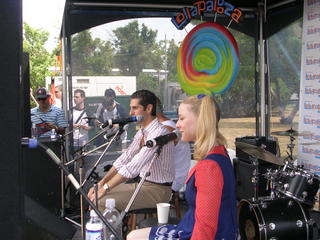 Early Saturday morning the city received some welcomed rain after consecutive days of high humidity and very little relief. For the organizers of Lollapalooza, the rain was probably not on their schedule. In a way, the downpour acted as a baptism for this much heralded festival. The lost summer Lollapalooza experienced in 2004 because of poor ticket sales forced its creator, Perry Farrell, to reinvent his traveling musical revue. With the aid of Capital Sports & Entertainment (CSE) and Charles Attal Presents, Lollapalooza received an overhaul. The two entertainment organizations, both based in Austin, Texas, came into Lollapalooza's life with a serious knowledge of how to make a festival work having had enormous success with the Austin City Limits Music Festival, now entering its third year. Instead of a multi-city festival, Lollapalooza's wide scope was downsized into a more focused approach. On April 22, 2005, plans were finally secured and an annoucement was made that revealed Chicago as the new official home for Lollapalooza.
Early Saturday morning the city received some welcomed rain after consecutive days of high humidity and very little relief. For the organizers of Lollapalooza, the rain was probably not on their schedule. In a way, the downpour acted as a baptism for this much heralded festival. The lost summer Lollapalooza experienced in 2004 because of poor ticket sales forced its creator, Perry Farrell, to reinvent his traveling musical revue. With the aid of Capital Sports & Entertainment (CSE) and Charles Attal Presents, Lollapalooza received an overhaul. The two entertainment organizations, both based in Austin, Texas, came into Lollapalooza's life with a serious knowledge of how to make a festival work having had enormous success with the Austin City Limits Music Festival, now entering its third year. Instead of a multi-city festival, Lollapalooza's wide scope was downsized into a more focused approach. On April 22, 2005, plans were finally secured and an annoucement was made that revealed Chicago as the new official home for Lollapalooza.The rain had cleared up by about 9:30 A.M. The sun fought its way through some clouds as the hour drew closer for the day's first two performers, The Redwalls and The (International) Noise Conspiracy, to launch Day One. During a pre-show press conference, Charlie Jones, a spokesperson for CSE, described Grant Park as Chicago's "crown jewel," and expressed the hopes of the organizers to make Lollapalooza "the greatest fest in the country." For Perry Farrell, it had been a long journey since 1991, when the festival was first started. In a city where rock bands like The Smashing Pumpkins were denied entry into its prized park to perform for free, Chicago did not simply turn a cheek lightly when the idea to hold Lollapalooza was presented. What made performances by Sting and Shania Twain get the free pass into Grant Park was the major incentive the city would get in return: money. "It was like a beautiful woman," said Farrell on courting the city government. "She took her time." It is reported that the promoters' deal with the city outlined a donation of $250,000 to the Parkways Foundation, the presenters of Lollapalooza.
 Fresh from a supporting slot for Oasis on their U.K. stadium tour, The Redwalls had the distinct honor of being the first local act to start the day. Going from Metro to Manchester Stadium was quite a leap for this four piece out of Deerfield, IL. Set to play at 11:45 A.M., generally not an hour to play a concert, The Redwalls took to their stage with sheer confidence. Liam Gallagher of Oasis must have had made an impact on Redwalls guitarist Logan Baren who seemed to take on some of the Oasis frontman's stage mannerisms and vocal swagger, not to mention wearing sunglasses presented to him by the younger Gallagher. "I think we would have been more nervous if we hadn't done the Oasis thing," said bassist Justin Baren, younger brother to Logan, about the prospect of playing to a large outdoor crowd. The band was welcomed by a strong sized crowd that surpassed any concerns the band may have had on the early time slot. Said Justin after the band's set, "I was nervous that not a lot of people would show up that early, but it turned out great."
Fresh from a supporting slot for Oasis on their U.K. stadium tour, The Redwalls had the distinct honor of being the first local act to start the day. Going from Metro to Manchester Stadium was quite a leap for this four piece out of Deerfield, IL. Set to play at 11:45 A.M., generally not an hour to play a concert, The Redwalls took to their stage with sheer confidence. Liam Gallagher of Oasis must have had made an impact on Redwalls guitarist Logan Baren who seemed to take on some of the Oasis frontman's stage mannerisms and vocal swagger, not to mention wearing sunglasses presented to him by the younger Gallagher. "I think we would have been more nervous if we hadn't done the Oasis thing," said bassist Justin Baren, younger brother to Logan, about the prospect of playing to a large outdoor crowd. The band was welcomed by a strong sized crowd that surpassed any concerns the band may have had on the early time slot. Said Justin after the band's set, "I was nervous that not a lot of people would show up that early, but it turned out great."
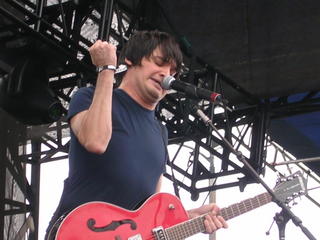 Following The (International) Noise Conspiracy's set was ...And You Will Know Us By The Trail Of Dead. The band furiously attacked the afternoon by making the most of their hour set, trashing their instruments in the end. Walking the grounds between stages provided a chance to see at what point the sound from opposite stages bled into each other. If one were to stand in the middle of the field, they would get a mix of both stages. The closer you were to a particular stage the less likely you would hear the other act performing across the field. Being that every band faced simultaneous time slots they couldn't help but notice another artist on their time.
Following The (International) Noise Conspiracy's set was ...And You Will Know Us By The Trail Of Dead. The band furiously attacked the afternoon by making the most of their hour set, trashing their instruments in the end. Walking the grounds between stages provided a chance to see at what point the sound from opposite stages bled into each other. If one were to stand in the middle of the field, they would get a mix of both stages. The closer you were to a particular stage the less likely you would hear the other act performing across the field. Being that every band faced simultaneous time slots they couldn't help but notice another artist on their time.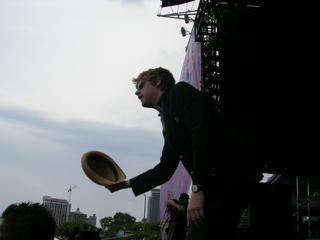 Singer Ricky Wilson of the Kaiser Chiefs pointed out this very fact when over at the SBC West stage Liz Phair began her performance. As brash as he was amusing, Wilson inquired who that "lady" was on the neighboring stage. Fans yelled out to Wilson, "Liz Phair!" He glanced over to Phair's side of the field and recommended she keep it down. "Tell her we're working," said Wilson. The band thrashed through their set as their singer pushed the limits of his already shredded voice ("I left my voice in Washington last night," said Wilson). Wilson later climbed the stage supports and turned the microphone over to two fans after his voice finally gave out.
Singer Ricky Wilson of the Kaiser Chiefs pointed out this very fact when over at the SBC West stage Liz Phair began her performance. As brash as he was amusing, Wilson inquired who that "lady" was on the neighboring stage. Fans yelled out to Wilson, "Liz Phair!" He glanced over to Phair's side of the field and recommended she keep it down. "Tell her we're working," said Wilson. The band thrashed through their set as their singer pushed the limits of his already shredded voice ("I left my voice in Washington last night," said Wilson). Wilson later climbed the stage supports and turned the microphone over to two fans after his voice finally gave out. Liz Phair, on the other hand, lacked all the spontaneity the Kaiser Chiefs displayed during their set. Phair, who has long since left Chicago for Los Angeles, walked through her set with little excitement. Her backing band almost reduced Phair to some coffee house open-mic performer. A new song called "Everything To Me" was close to being jettisoned due to her guitarist having issues with his guitar. There was some confusion when Phair announced she would tackle a song on her own. As if unsure what to do, her bassist and drummer stepped into what was supposed to be a solo Phair doing "6'1"" while her guitarist figured out his problems. It would have been a nice treat if Phair had in fact dumped "Everything To Me." What will no doubt become a single from her upcoming album, the song screamed of something Sheryl Crow would have written for her cycling boyfriend Lance Armstrong. It's hard to even associate Phair with Chicago anymore. Her stale performance gave all the more reason why Phair didn't deserve a spot on the Lollapalooza bill. She can test the boundaries of human sexuality in song all she wants but commanding a festival sized stage she can not. At least John Cusack had a good view from the side of the stage.
Liz Phair, on the other hand, lacked all the spontaneity the Kaiser Chiefs displayed during their set. Phair, who has long since left Chicago for Los Angeles, walked through her set with little excitement. Her backing band almost reduced Phair to some coffee house open-mic performer. A new song called "Everything To Me" was close to being jettisoned due to her guitarist having issues with his guitar. There was some confusion when Phair announced she would tackle a song on her own. As if unsure what to do, her bassist and drummer stepped into what was supposed to be a solo Phair doing "6'1"" while her guitarist figured out his problems. It would have been a nice treat if Phair had in fact dumped "Everything To Me." What will no doubt become a single from her upcoming album, the song screamed of something Sheryl Crow would have written for her cycling boyfriend Lance Armstrong. It's hard to even associate Phair with Chicago anymore. Her stale performance gave all the more reason why Phair didn't deserve a spot on the Lollapalooza bill. She can test the boundaries of human sexuality in song all she wants but commanding a festival sized stage she can not. At least John Cusack had a good view from the side of the stage.The Ohio duo The Black Keys disproved any comparisons to The White Stripes. Dan Auerbach's fluid style of play on the guitar expressed a clear leaning towards the blues, while Patrick Carney's drumming added that extra ingredient that made them a rock band. It was no wonder why the famed blues label Fat Possum Records took this band in. The Black Keys completely took a part The Beatles' "She Said, She Said," turning it into a smashing, psychedelic, blues infused tune.
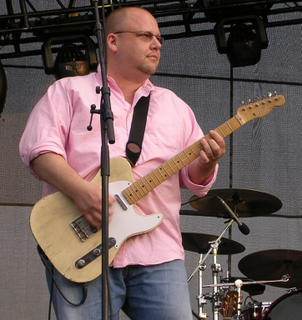 "And now for the fun stuff," said Perry Farrell to an eager audience looking to see the Pixies make their appearance. Since reforming at the 2004 Coachella Valley Music Festival in Indio, California, the Pixies remained a hot ticket, selling out five consecutive nights at the Aragon Ballroom just this past November in Chicago. As the only band brought back from the failed Lollapalooza 2004 lineup, the Pixies took a co-headlining position alongside Weezer. Farrell wrapped up his introduction by calling the Pixies, "One of the seminal rock bands of the 80's." Facing the Chicago skyline, the Pixies delievered the usual standards that have been part of their reunion set for a year. Fans still roared to the sounds of "Head On," "Debaser," and "Where Is My Mind?"
"And now for the fun stuff," said Perry Farrell to an eager audience looking to see the Pixies make their appearance. Since reforming at the 2004 Coachella Valley Music Festival in Indio, California, the Pixies remained a hot ticket, selling out five consecutive nights at the Aragon Ballroom just this past November in Chicago. As the only band brought back from the failed Lollapalooza 2004 lineup, the Pixies took a co-headlining position alongside Weezer. Farrell wrapped up his introduction by calling the Pixies, "One of the seminal rock bands of the 80's." Facing the Chicago skyline, the Pixies delievered the usual standards that have been part of their reunion set for a year. Fans still roared to the sounds of "Head On," "Debaser," and "Where Is My Mind?" But the Pixies acted very distant as they flipped through their songs like you would flip through a magazine where you simply look at the pictures. They might have been working off the set list they intended to use for their headlining spot on last year's Lollapaloooza. Interaction with the crowd was nonexistent. When you've cashed a check for a reported $270,000 then maybe there's no obligation to have to talk to a crowd.
But the Pixies acted very distant as they flipped through their songs like you would flip through a magazine where you simply look at the pictures. They might have been working off the set list they intended to use for their headlining spot on last year's Lollapaloooza. Interaction with the crowd was nonexistent. When you've cashed a check for a reported $270,000 then maybe there's no obligation to have to talk to a crowd.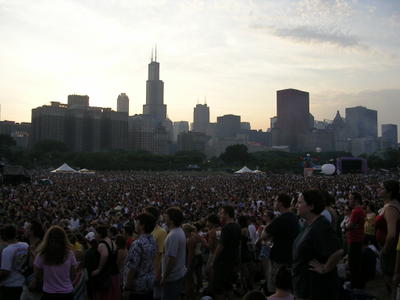
 ##Photo By: John Castaneda
##Photo By: John Castaneda Park District Superintendent Tim Mitchell joined Farrell on stage before Weezer arrived for their set. The day had ran smoothly, and Mitchell's face, as he scanned the 33,000 in attendance, conveyed a sense of satisfaction; that organizing this festival might be a good thing for the city afterall. But the attention was soon redirected to Rivers Cuomo and company as they grabbed their instruments and sent the crowd into a frenzy with the opener "Say It Ain't So." Weezer mixed the old with the new and made more of a connection with the crowd than the Pixies had done. Cuomo struck the occasional rock guitarist pose, feeding off the crowd and making every song count. Watching Patrick Wilson work behind the drumkit was like being able to see a younger Bun E. Carlos of Cheap Trick--each possessing flare and power with the drums. "We're so happy to be a part of Lollapalooza, finally," said Cuomo to the sea of hands forming W's in the air, chanting the band's name.
Park District Superintendent Tim Mitchell joined Farrell on stage before Weezer arrived for their set. The day had ran smoothly, and Mitchell's face, as he scanned the 33,000 in attendance, conveyed a sense of satisfaction; that organizing this festival might be a good thing for the city afterall. But the attention was soon redirected to Rivers Cuomo and company as they grabbed their instruments and sent the crowd into a frenzy with the opener "Say It Ain't So." Weezer mixed the old with the new and made more of a connection with the crowd than the Pixies had done. Cuomo struck the occasional rock guitarist pose, feeding off the crowd and making every song count. Watching Patrick Wilson work behind the drumkit was like being able to see a younger Bun E. Carlos of Cheap Trick--each possessing flare and power with the drums. "We're so happy to be a part of Lollapalooza, finally," said Cuomo to the sea of hands forming W's in the air, chanting the band's name.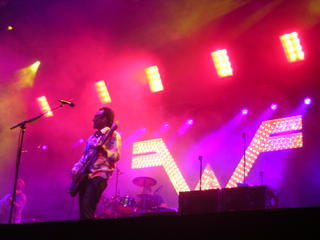 Lollapalooza's first day was a success. The weather never caused any detours, and the heat was replaced by moderately cool tempertures. The early afternoon sets saw an overcast of clouds while the sun finally broke out in the early evening hours to provide a pleasurable setting. Organizers may have breathed a sigh of relief by the end of the night, but there was still one more day to go.
Lollapalooza's first day was a success. The weather never caused any detours, and the heat was replaced by moderately cool tempertures. The early afternoon sets saw an overcast of clouds while the sun finally broke out in the early evening hours to provide a pleasurable setting. Organizers may have breathed a sigh of relief by the end of the night, but there was still one more day to go.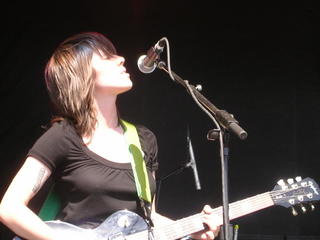 Sunday's weather was expected to reach 100 degrees with a humidity level thick as a brick wall. The wind that would blow through the field would pick up the dirt off the baseball diamonds and become a gust of warm, dusty wind. A security guard working the Parkways Stage, part of a security company from Iowa, described how the heat played into their hands to keep crowds in control. Basically, everyone was too tired to argue with security. Keeping the crowds in control weighed less than keeping the crowds hydrated, which organizers and security accomplished very well. Water stations were in place to allow people to refill their water bottles. Free ice and water was given to people in crowds. When the music wasn't coming from any of the stages there was a quiet air to the fest. People sought out shade and water as fast and as often as they could.
Sunday's weather was expected to reach 100 degrees with a humidity level thick as a brick wall. The wind that would blow through the field would pick up the dirt off the baseball diamonds and become a gust of warm, dusty wind. A security guard working the Parkways Stage, part of a security company from Iowa, described how the heat played into their hands to keep crowds in control. Basically, everyone was too tired to argue with security. Keeping the crowds in control weighed less than keeping the crowds hydrated, which organizers and security accomplished very well. Water stations were in place to allow people to refill their water bottles. Free ice and water was given to people in crowds. When the music wasn't coming from any of the stages there was a quiet air to the fest. People sought out shade and water as fast and as often as they could.The sun baked the Parkways Stage as Tegan And Sara performed. The twin sisters made themselves prime targets for the sun by both dressing in black. Sara (seen above) suffered a heat stroke and was unable to carry on with the set. As much of a disappointment to fans, it was surely a disappointment to the band who fought off the weather as best as they could. In the end, health was more important than getting to the next song. Meanwhile at the SBC East stage, Perry Farrell unveiled his group Satellite Party. Like Farrell, the band was over the top, including bassist Tony Kanal of No Doubt, ex-Extreme guitarist Nuno Bettencount, and a dancing trio called the Lolla Girls.
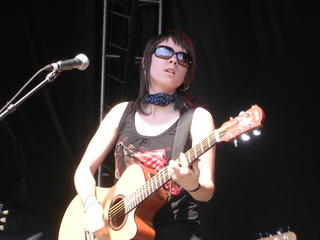
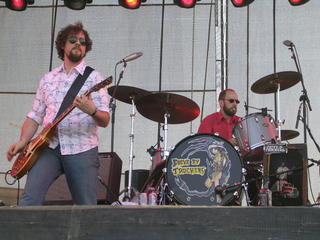 The Drive-By-Truckers arrived to the SBC West stage with guitar licks and fat bottomed bass; not to mention their own stash of Pabst Blue Ribbon, the drink of choice for these southerners. The heat remained in full effect as evening sets by The Arcade Fire and Spoon proceeded. Widespread Panic was alotted two and a half hours split into two time slots. The jam band restrained themselves and stuck to songs during their 6:30 P.M. slot and saved the marathon jam fests for the final headlining spot. The real anticipation was reserved for The Killers.
The Drive-By-Truckers arrived to the SBC West stage with guitar licks and fat bottomed bass; not to mention their own stash of Pabst Blue Ribbon, the drink of choice for these southerners. The heat remained in full effect as evening sets by The Arcade Fire and Spoon proceeded. Widespread Panic was alotted two and a half hours split into two time slots. The jam band restrained themselves and stuck to songs during their 6:30 P.M. slot and saved the marathon jam fests for the final headlining spot. The real anticipation was reserved for The Killers.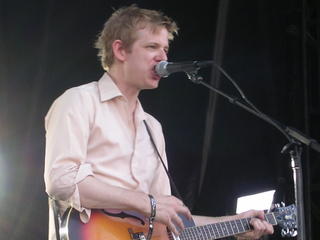
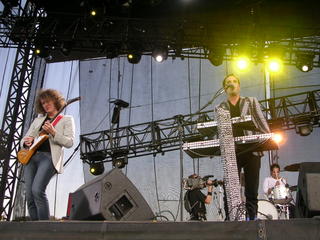 The Killers have gone from a band with some buzz to a band you can not escape. While their debut album Hot Fuss as been one of the most successful EPs in the guise of an album, the heavy momentum for The Killers as continued to carry them higher and higher. Singles like "Somebody Told Me," "Mr. Brightside," and "All These Things That I've Done" all seem to have hit the airwaves at the right time, keeping this Las Vegas band fresh in the ears of listeners. Singer Brandon Flowers embraced Perry Farrell after his introduction and as soon as "Jenny Was A Friend Of Mine" hit its first note, The Killers owned the crowd. Maybe to fans gathering for Death Cab For Cutie at the Budweiser Select stage, The Killers did not deserve their time. The Killers certainly don't scream "indie," but you had to wonder if their performance of the tongue in cheek "Indie Rock And Roll" wasn't directed towards those that act the role of musical connoisseur.
The Killers have gone from a band with some buzz to a band you can not escape. While their debut album Hot Fuss as been one of the most successful EPs in the guise of an album, the heavy momentum for The Killers as continued to carry them higher and higher. Singles like "Somebody Told Me," "Mr. Brightside," and "All These Things That I've Done" all seem to have hit the airwaves at the right time, keeping this Las Vegas band fresh in the ears of listeners. Singer Brandon Flowers embraced Perry Farrell after his introduction and as soon as "Jenny Was A Friend Of Mine" hit its first note, The Killers owned the crowd. Maybe to fans gathering for Death Cab For Cutie at the Budweiser Select stage, The Killers did not deserve their time. The Killers certainly don't scream "indie," but you had to wonder if their performance of the tongue in cheek "Indie Rock And Roll" wasn't directed towards those that act the role of musical connoisseur.When Death Cab For Cutie did hit the stage the night was near its end. Lollapalooza had survived the rain, the heat, and managed to run close to schedule. But there was still an aspect to the newly designed festival that didn't quite live up to its reputation. That one element was diversity. The four stages in Hutchinson Field were mainly an all-rock affair. Across S. Columbus Drive was the Planet Stage, the lone area to catch any sort of hip-hop or house music acts. This section of the park felt more like a small block party that happened to be next door to a major music festival. They were outsiders to a festival just a few feet away. Only the Digable Planets, Saul Williams, and G Love & Special Sauce had the opportunity to take on some of the main stages in the park. Organizers may want to reconsider the festival's configuration if it wants to create a real, diverse musical atmosphere.
The question of whether or not Lollapalooza will every capture the sparkle of magic it displayed in the early 90's is irrelevant by 2005. The festival is whatever the bands and the fans make it. There's a reason why critics do not closely examine Coachella or the Austin City Limits Festival--they are relatively young festivals without the body of history Lollapalooza has amassed in its time. Lollapalooza emerged at the right place and the right time. For now, Perry Farrell should be happy with the new home for his festival. Chicago should realize that the city is now in a position to contend with cities like Austin, Texas that have been synonymous with music festivals. Lollapalooza will be able to attract the types of artists that people may not be able to see at annual fests like the Chicago Blues Fest or the Taste of Chicago.
The beginning of a beautiful relationship? So far, so good.

1 comment:
Wow I felt like I was there, Great pictures were you like right there, front row. Keep up the good work I can relive my youth through your reviews.
Post a Comment